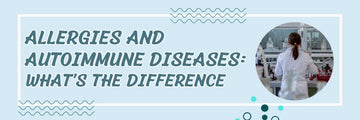Intolerance Blog
Delving Deeper Into a Tomato Allergy
by Dr. Joseph Nightingale .
on
Dec 01, 2024
https://youtu.be/RI4C2-h7ep0
Do you ever get an itchy mouth or stomach ache after eating tomatoes? Maybe that's a pasta sauce, pizza, or just a regular salad. Some allergies are extremely well-known – think peanuts, wheat, or dairy. However, tomato allergy flies under the radar despite affecting a sizeable number of people.
In this article, we explore why some people are allergic to tomatoes, how to know if you are, and what you can do about it.
Tomato Allergy or Nightshade Allergy?
Tomatoes are part of the
Solanaceae family of plants. Otherwise known as "nightshades," it includes aubergine (eggplant), peppers, chillis, white potatoes, and goji berries.
Nightshades contain alkaloids – a group of toxic chemicals that protect the plant from moulds and pests. Common alkaloids in tomatoes and other nightshades include capsaicin, solanine, and nicotine. Capsaicin might sound familiar – it's what gives chilli peppers their spice.

For some people, alkaloids can trigger an allergic reaction, as the body wrongly flags these compounds as a threat. However, for others, nightshades are merely an intolerance, causing symptoms like bloating, heartburn, nausea, and diarrhoea.
In most people, however, tomato allergy is caused by
oral allergy syndrome (OAS). This occurs when a person is allergic to pollen and develops a "cross-reactivity" to similar compounds found in fruits. Usually, individuals with OAS will only react to raw tomatoes. Moreover, tomatoes contain high levels of histamine – a compound released during an allergic reaction – further exacerbating symptoms.
Interestingly, UK researchers recently identified a third allergy type:
Lipid Transfer Protein (LTP) allergy. According to their report, LTP allergy occurs regardless of whether the tomato is raw or cooked and can cause a severe allergic response.
Tomato Allergy Symptoms
True tomato allergies (aka a nightshade allergy), although rare, affect the skin, sinuses, eyes, and airway. It should present similar to an LTP allergy. Common symptoms include:
- Skin reactions like hives, rashes, or eczema
- Itching or tingling in and around the mouth
- Stomach issues such as cramping, nausea, vomiting, or diarrhoea
- Sneezing, runny nose, or nasal congestion
- Watery, itchy eyes
- Wheezing, coughing, or difficulty breathing
Severe reactions can occur in a true allergy – this is known as
anaphylaxis. Identifying the early signs of this medical emergency is critical as it can be life-threatening. Seek immediate medical attention if you suspect anaphylaxis.
The ABC symptoms are a way to remember the critical aspects of this reaction:
-
AIRWAY: Difficulty breathing, throat tightness, hoarseness, or a sensation of throat closure.
-
BREATHING: Shortness of breath, wheezing, or rapid breathing.
-
CIRCULATION: Symptoms include pale or blue skin, fainting, dizziness, weak pulse, or shock.
In contrast, OAS usually present with milder symptoms that occur immediately following exposure. These include a slight itchy or tingling sensation and mild swelling of the lips, mouth, and tongue. OAS symptoms are more common when seasonal pollen count is high.
Diagnosing Tomato Allergy
Differentiating between a true tomato allergy and OAS is difficult. Consider the time of year when the allergy is present and the severity of the symptoms. Otherwise, several tests are available to aid the diagnosis:
-
Blood Test: This involves taking a blood sample and testing for the presence of antibodies to tomato allergens. Our Allergy & Intolerance Test Plus, for example, analyses IgE and IgG4 levels for common allergens, including tomatoes.
-
Skin Prick Test: This test involves placing a small amount of the allergen on the skin and then pricking the skin to introduce the allergen. If an allergic reaction occurs, it suggests an allergy to the substance.
-
Oral Food Challenge: You will be given a small amount of tomato to eat and then monitored for any allergic reactions. It is important to note that only a qualified healthcare professionalshould perform these tests.
-
Food Diary: Keeping a detailed food diary can help track symptoms and identify potential triggers, including tomatoes. This method involves recording everything you eat and any symptoms that follow to help determine if there is a correlation with tomato consumption.
Treating Tomato Allergy
For most people, avoiding the allergen will prevent any symptoms from occurring. However, given the ubiquity of tomatoes in Western diets, mild exposure at some point is all but inevitable. Antihistamines can help treat mild to moderate symptoms caused by an allergic reaction. But, in severe cases, an immediate injection by an adrenaline auto-injector (Epi-pen) is necessary to prevent anaphylaxis.
Get Test for Tomato Allergy with Test Your Intolerance
Diagnosing a tomato allergy can be accomplished through various methods such as blood tests, skin prick tests, oral food challenges, and maintaining a food diary.
Our
Allergy & Intolerance Test Plus is an excellent option for a comprehensive analysis of potential allergies and intolerances. This home-to-lab test screens for 117 common triggers, including 38 allergies and 79 intolerances.
If you're experiencing symptoms related to food or environmental triggers, consider taking this test for a detailed understanding of your potential allergies and intolerances.
Author: Dr. Joseph Nightingale, MBBS, MSc., Health and Science Copywriter and Qualified Doctor
Dr. Joseph Nightingale, MBBS, MSc, is a qualified medical doctor, and copywriter, specialising in creating clear content for organisations. With a master's degree in Biodiversity, he’s also done notable research on climatological impact.
Read more about Dr. Joseph Nightingale
 For some people, alkaloids can trigger an allergic reaction, as the body wrongly flags these compounds as a threat. However, for others, nightshades are merely an intolerance, causing symptoms like bloating, heartburn, nausea, and diarrhoea.
In most people, however, tomato allergy is caused by oral allergy syndrome (OAS). This occurs when a person is allergic to pollen and develops a "cross-reactivity" to similar compounds found in fruits. Usually, individuals with OAS will only react to raw tomatoes. Moreover, tomatoes contain high levels of histamine – a compound released during an allergic reaction – further exacerbating symptoms.
Interestingly, UK researchers recently identified a third allergy type: Lipid Transfer Protein (LTP) allergy. According to their report, LTP allergy occurs regardless of whether the tomato is raw or cooked and can cause a severe allergic response.
For some people, alkaloids can trigger an allergic reaction, as the body wrongly flags these compounds as a threat. However, for others, nightshades are merely an intolerance, causing symptoms like bloating, heartburn, nausea, and diarrhoea.
In most people, however, tomato allergy is caused by oral allergy syndrome (OAS). This occurs when a person is allergic to pollen and develops a "cross-reactivity" to similar compounds found in fruits. Usually, individuals with OAS will only react to raw tomatoes. Moreover, tomatoes contain high levels of histamine – a compound released during an allergic reaction – further exacerbating symptoms.
Interestingly, UK researchers recently identified a third allergy type: Lipid Transfer Protein (LTP) allergy. According to their report, LTP allergy occurs regardless of whether the tomato is raw or cooked and can cause a severe allergic response.











